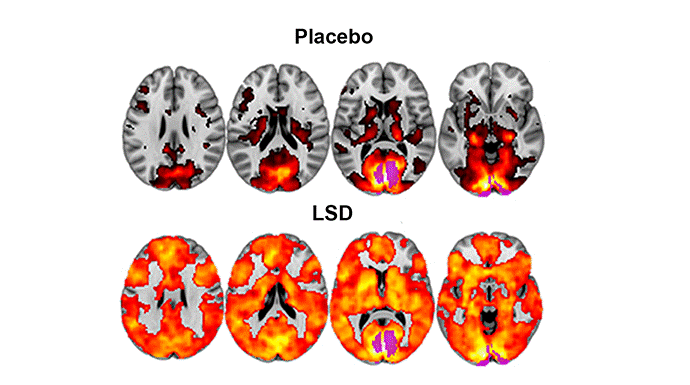The future is bright; its colours, sights and sounds more vibrant and steeped in a better understanding of our consciousness and it’s brought to you by the wonders of psychedelic science. It is a field of study with a storied history that is experiencing a renascence as countries around the world and their governments begin to open their minds.
For those who have experienced the wonders of psychedelics, the benefits they can offer are clear. It’s easy to explain that elated sense of being and self to someone who is already an enthusiast, but for the rest of the world science is the key. That is why researchers in this field want to bring science and psychedelics together, as they once were, and in the past several years they have done just that.
Within the US the Multidisciplinary Association of Psychedelic Studies (MAPS) is on the verge of receiving FDA approval of its MDMA-assisted therapy for patients with PTSD.
A year ago MAPS wrapped up six trails conducted in the US, Israel, Switzerland and Canada in which treatment resistant PTSD was treated with MDMA inspired therapy.
It’s proven to be an immensely effective form of treatment which is on track for wide-scale approval by 2021. The latest study, which included 107 participants, found that 66 percent of patients no longer qualified for PTSD after just two sessions. In their previous study that number was 83 percent.
The success of these trials has launched MAPS into the final phase of FDA approval in which they will continue their clinical trials as well as provide training for up to 100 therapists to be certified in administering MDMA-assisted therapy.
Brad Burge, Director of Strategic Communications for MAPS, insists that the FDA and even the DEA have been extremely cooperative with their studies. He’s seen a great reception for these alternative therapies from the scientific community and their patients and expects greater acceptance as the studies continue.
“I think that the momentum is strong enough and the need for alternatives is great enough that any sort of counter marketing that big pharmaceuticals would do would probably only make what we’re doing more popular.” Says Burge.
As with anything, there are also potential risks, but Burge notes that a large part of the government’s acceptance of their studies has come from the careful procedures and practices they’ve adopted. Safe storage, in house administration of drugs and most of all an openness in communication with the patient.
“As far as any sort of addictive potential,” Brad says, “there is zero evidence that a couple of administrations of MDMA in a therapeutic setting will lead to any form of dependence.”
Of the 107 patients that have been treated by MAPS, only a couple have sought out the substance outside of their scheduled therapies, those patients were compelled by the results MDMA provided yet they later admitted – as Burge also insists – that the therapy is a crucial element.
As a result of such studies, MDMA is likely to go the way of marijuana, in that its medicinal usefulness will eventually lead to widespread acceptance.
But one psychedelic which still has a long way to go in quelling the public stigma is ironically one which could also do a lot to ease people’s fears: LSD. Widely unknown to the public, the experience of LSD is often thought of as a hallucination-inducing brain-melter. Even film portrayals of acid trips have had a difficult time capturing the true experience.
Among those who have taken the substance, it is often thought to have a positive transformational effect in their lives, especially when — as with MDMA — it is administered properly and in a comfortable environment. Yet the difficulty in conveying the experience has made LSD one of the most feared drugs in the world.
Much of that fear has to do with a lack of information, and short inviting the whole world to experience it for themselves in the style of Timothy Leary, rigorous scientific study is the next best way to lift that veil.
That’s where the Beckley Foundation of the UK comes in. Their organization, which aims to bring science back into the world of psychedelics, is helping us all gain a better understanding of both the substance and our own consciousness.
When we last spoke with Amanda Feilding, director and founder of Beckley, they had been testing the effects of psilocybin (the active chemical in magic mushrooms) on depression with incredible results. Now she says her focus is mainly on LSD.
“Poor LSD is still not acceptable,” Feilding says with a sense of despair in her voice that only someone who truly understands the substance could convey, “there’s still a terrible taboo on those letters.”
Having lived in the world of psychedelics since their heyday Amanda has seen the effects in science, medicine and the counterculture of the 60s. She has also seen a decade’s long misinformation campaign which has stigmatized recreational users and the years of scientific research with them.
In the 1950s and 60s, more than 3000 research papers were published on the effects of LSD. Among these early researchers was Ronnie Sandison, whose work at Powick Hospital for the mentally ill had become recognized around the world as a breakthrough in the treatment of mental illness until LSD’s association with recreational users forced the compound into obscurity.
Even the founder of Alcoholics Anonymous, Bill Wilson lauded LSD as an aid in curing alcoholism — a possible use which the Beckley Foundation is also looking into. Wilson who famously believed that alcoholics required a spiritual awakening in order to overcome their addiction also believed that LSD could hold the key to that awakening.
Since its founding in 1998, the Beckley Foundation has sought to revive this field of study in the name of the public good it could do. With the use of modern scientific methods and brain imaging technologies Amanda and her team can now bring scientific backing to the experiences that underground users have known for years.
In 2016, the Beckley/Imperial Research Programme produced the first images of the brain on LSD. The study was conducted on 20 volunteers, whose brains were scanned using fMRI and magnetoencephalography (MEG) after receiving either 75 micrograms of LSD or placebo.

“It shakes the rigidity of the setting,” Amanda explains, “Mental and psychological disorder like depression, addiction, PTSD are set on hyperactivity in parts of the Default Mode Network, which is like the ego, its set into a rigid and negative setting.”
For recreational users, the images provided a visual representation of the illusive ego death. The concept is something of a mythologized holy grail of psychedelics or a state of nirvana that is now better understood by looking at the way in which LSD affects the brain.
“Ego death or ego disintegration is really the same as the flip side of the expression of the mystical experience.” Amanda says, “The ego is basically the control mechanism to keep the status quo as it is, when that diminishes in its activity there is a flood of other activity which is rather like when the cat is away the mice will play.”
That level of free-form thought can be quite overwhelming, especially when the average trip could take up to 8-10 hours. This is why Amanda emphasizes that the proper setting — and in the case of Beckley’s studies: a therapeutic guide — is important to ensure a positive experience. She also believes that maintaining a regular blood glucose level is an effective way to ensure clarity and stave off a bad trip. It’s one theory she aims to test in upcoming studies.
Among its’s newest ventures, the Beckley/Imperial Research Programme will undergo the world’s first microdosing study to investigate reports that minor doses of around 15 micrograms increase productivity while still allowing the user to function normally. The study will have volunteers play the ancient Chinese strategy game of Go, with one player having taken a microdose and the other a placebo, to investigate whether small doses of LSD can enhance intuitive pattern recognition and creativity. All of which is to increase our understanding of LSD, rather than base our knowledge on years of misinformation.
As a once recreational user, Amanda is aware of the stigma that can affect its widespread acceptance, but also believes that there are immense benefits in bringing it out of the dark.
“I think LSD has gone through a great black tunnel of publicity.” She says, “In many ways I think one can say that it’s the most adaptable and positive of all the drugs because what it does is expand the inner person.”
For her, Beckley’s work is about a much more than having a way to legally access a drug again. “It’s a social duty if you like, it’s much easier to just take LSD when you’re not having to change the world.”
In fact, LSD is quite available already and even relatively inexpensive on the black market, but the point of psychedelic science is education rather than access. Understanding these feared substances and the way they affect the body can ultimately help us to provide the safest possible methods of using them. Whether it be recreational or medicinal, more information is always better than propaganda, but wherever the future of psychedelics leads, it’s sure to be a more enlightened place thanks to psychedelic scientists.
To support the research of MAPS and the Beckley Foundation visit the links below:




